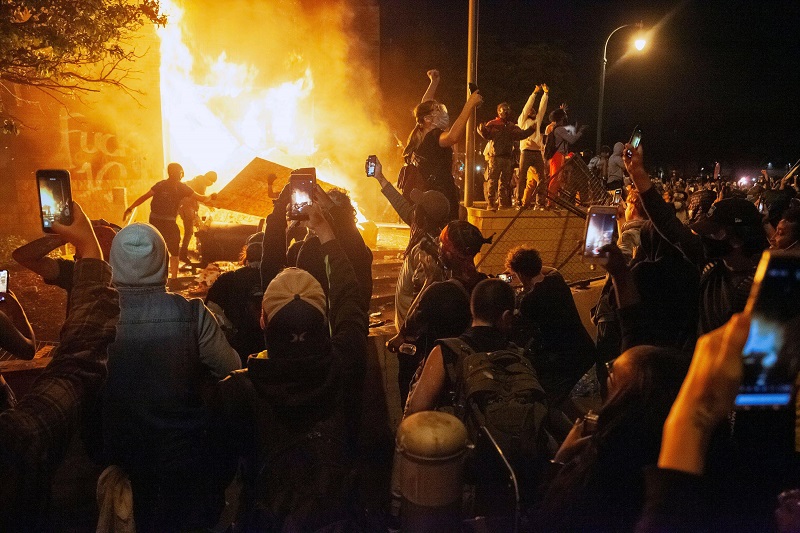
In public debate, whether in social media posts, legacy media, or legislative bodies, lines get artificially drawn to conveniently avoid the necessary intelligence of ambiguity. In the aftermath of Ferguson, Portland, Minneapolis, Washington, DC, Kenosha, and recently our neighbors to the north the lines divide protestors v. police. We all know that it is not that simple.
At the crux of these issues are the Constitutional guarantees of the citizen’s “right of the people peaceably to assemble” etched in the First Amendment, and the Fourth Amendments right “to be secure in their persons, houses, papers, and effects, against unreasonable searches and seizures.” These fundamental understandings of the federal government’s role in maintaining a free and orderly society were not initially applied to the states through the U.S. Constitution but were not foreign to the states’ governmental structure. The Fourteenth Amendment did press those principles and the entirety of the U.S. Constitution to apply to the states.
Because of the oppression felt by the Colonists that led to the Revolutionary war, the documents of government recognized the general police power of legitimate government but were cautious about establishing formal police agencies. The evolution of federal and local law enforcement began with the U.S. Marshals, local sheriffs and eventually city police, and lastly state law enforcement agencies. When it came to quelling civil disturbances, the only force large enough to respond to a large number of disgruntled citizens was the military.
In 1878, after years of seeing uniforms everywhere, the federal Posse Comitatus act limited enforcement of domestic laws by the military. The term refers to any gathering of citizens by authorities when a force of persons is needed as in the old western movies to capture a band of stagecoach raiders, known by the shortened term posse. Prior to the federal act, there were a series of nearly 100 riots listed in American history. When the National Guard is called out, they are typically restricted to assisting local law enforcement with limited duties or assigned to non-arrest assignments such as traffic direction and medical support.
We recount this history to say that the primary responsibility during civil disturbances rests on the shoulders of the same cops that take your burglary report and stop drunk drivers. This sets up the emotional conflict between local protestors and local law enforcement. It is the classic and perpetual balance between free speech for all and freedom from injury, damage, and fear for all.
When does the peaceable assembly protected under the Constitution (remember that rights are not given by the Constitution, but are God-given rights that pre-existed the Bill of Rights) become an act or event that no longer merits that protection? The best definition of liberty is that the freedom to swing my fist stops at my neighbor’s nose. Whatever actions cease to be peaceable cease to be Constitutionally protected. Of course, our courts are given the burden of defining that. Is honking in the parking lot of Planned Parenthood peaceable? Is blocking commerce on the highway peaceable? Setting fire to a building? Throwing feces at police? Using lasers to blind opponents?
When an assembly leaves the bounds of peace, the government’s police power can act to end the unlawful assembly using methods that are consistent with the reasonableness of potential arrests which are seizures under the Fourth Amendment.
What most citizens and media do not know when they see armed government agents in a phalanx and clad in protective clothing (i.e. riot gear), is that law enforcement is on the razor’s edge. They are accused of provoking violence by using the tools of their trade, but they will be criticized mercilessly if violence breaks out and they lack the tools to effectively bring a peaceful resolution. The uninformed also do not realize that in a great number of cases there are professional or trained volunteers whose purpose is to cause disruption and incite violence. They have their own intelligence-gathering strategies, including knowing where the police are, what their capabilities are, and what kind of support those officers will get from their agency and political leadership.
It is clear that riots change society. They work if they are allowed to work. Burning buildings ignite more than material. Photos and videos out of context with a propagandized narrative incite emotions of good citizens against the police. The most recent hundreds of destructive civil disturbances where property and lives were damaged and put at risk were effective in creating fear among politicians who enacted destructive, reactionary laws crippling law enforcement.
The real conflict is not what police officers have to decide to do when the grumbling and simmering are at an ignition point from protest to riot, but what the weak-willed political leaders do that enable such destruction.